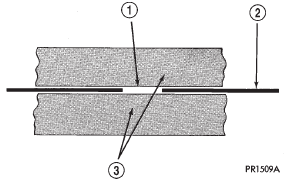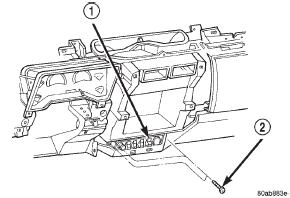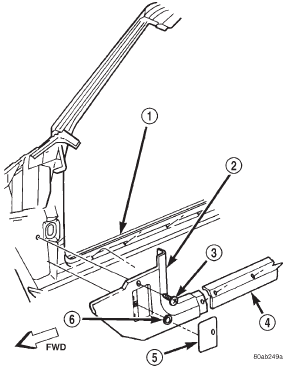Jeep Cherokee (XJ): Service procedures. Removal and installation
REAR GLASS HEATING GRID REPAIR Repair of the rear glass heating grid lines, bus
bars, terminals or pigtail wires can be accomplished
using a Mopar Rear Window Defogger Repair Kit
(Part Number 4267922) or equivalent.
WARNING: MATERIALS CONTAINED IN THE
REPAIR KIT MAY CAUSE SKIN OR EYE IRRITATION.
THE KIT CONTAINS EPOXY RESIN AND AMINE
TYPE HARDENER, WHICH ARE HARMFUL IF SWALLOWED.
AVOID CONTACT WITH THE SKIN AND
EYES. FOR SKIN CONTACT, WASH THE AFFECTED
AREAS WITH SOAP AND WATER. FOR CONTACT
WITH THE EYES, FLUSH WITH PLENTY OF WATER.
DO NOT TAKE INTERNALLY. IF TAKEN INTERNALLY,
INDUCE VOMITING AND CALL A PHYSICIAN
IMMEDIATELY. USE WITH ADEQUATE VENTILATION.
DO NOT USE NEAR FIRE OR FLAME. CONTAINS
FLAMMABLE SOLVENTS. KEEP OUT OF THE
REACH OF CHILDREN.
(1) Mask the repair area so that the conductive
epoxy can be applied neatly. Extend the epoxy application
onto the grid line or the bus bar on each side
of the break (Fig. 4).
1 - BREAK (2) Follow the instructions in the repair kit for
preparing the damaged area.
(3) Remove the package separator clamp and mix
the two conductive epoxy components thoroughly
within the packaging. Fold the package in half and
cut the center corner to dispense the epoxy.
(4) For grid line repairs, mask the area to be
repaired with masking tape or a template.
(5) Apply the epoxy through the slit in the masking
tape or template. Overlap both ends of the break
by at least 19 millimeters (0.75 inch).
(6) For a terminal or pigtail wire replacement,
mask the adjacent areas so the epoxy can be
extended onto the adjacent grid line as well as the
bus bar. Apply a thin layer of epoxy to the area
where the terminal or pigtail wire was fastened and
onto the adjacent grid line.
(7) Apply a thin layer of conductive epoxy to the
terminal or bare wire end of the pigtail and place it
in the proper location on the bus bar. To prevent the
terminal or pigtail wire from moving while the epoxy
is curing, it must be wedged or clamped.
(8) Carefully remove the masking tape or template.
CAUTION: Do not allow the glass surface to exceed
204 C (400 F) or the glass may fracture.
(9) Allow the epoxy to cure 24 hours at room temperature,
or use a heat gun with a 260 to 371 C
(500 to 700 F) range for fifteen minutes. Hold the
heat gun approximately 25.4 centimeters (10 inches)
from the repair.
(10) After the conductive epoxy is properly cured,
remove the wedge or clamp from the terminal or pigtail
wire. Do not attach the wire harness connectors
until the curing process is complete.
(11) Check the operation of the rear window defogger
glass heating grid. WARNING: ON VEHICLES EQUIPPED WITH AIRBAGS,
REFER TO GROUP 8M - PASSIVE RESTRAINT SYSTEMS
BEFORE ATTEMPTING ANY STEERING WHEEL,
STEERING COLUMN, OR INSTRUMENT PANEL COMPONENT
DIAGNOSIS OR SERVICE. FAILURE TO TAKE
THE PROPER PRECAUTIONS COULD RESULT IN
ACCIDENTAL AIRBAG DEPLOYMENT AND POSSIBLE
PERSONAL INJURY.
(1) Disconnect and isolate the battery negative
cable. (2) Remove the center bezel from the instrument
panel. See Instrument Panel Center Bezel in Group
8E - Instrument Panel Systems for the procedures.
(3) Remove the three screws that secure the accessory
switch bezel to the instrument panel (Fig. 5).
1 - ACCESSORY SWITCH BEZEL (4) Pull the accessory switch bezel out from the
instrument panel far enough to access the wire harness
connectors.
(5) Unplug the wire harness connectors from the
rear of the accessory switches and the cigar lighter/
power outlet.
(6) Remove the accessory switch bezel from the
instrument panel.
(7) With a small thin-bladed screwdriver, gently pry
the snap clips at the top and bottom of the rear window
defogger switch receptacle on the back of the accessory
switch bezel and pull the switch out of the bezel.
(8) Reverse the removal procedures to install. Be
certain that both of the switch snap retainers in the
receptacle on the back of the accessory switch bezel
are fully engaged. Tighten the mounting screws to
2.2 N·m (20 in. lbs.). WARNING: ON VEHICLES EQUIPPED WITH AIRBAGS,
REFER TO GROUP 8M - PASSIVE RESTRAINT SYSTEMS
BEFORE ATTEMPTING ANY STEERING WHEEL,
STEERING COLUMN, OR INSTRUMENT PANEL COMPONENT
DIAGNOSIS OR SERVICE. FAILURE TO TAKE
THE PROPER PRECAUTIONS COULD RESULT IN
ACCIDENTAL AIRBAG DEPLOYMENT AND POSSIBLE
PERSONAL INJURY.
(1) Disconnect and isolate the battery negative cable.
(2) Remove the fuse access panel by unsnapping it
from the right cowl side trim panel. (3) Remove the stamped nut that secures the right
cowl side trim to the junction block stud (Fig. 6).
1 - RIGHT FRONT DOOR SILL (4) Remove the screw located above the fuse access
opening that secures the right cowl side trim to the
right cowl side inner panel.
(5) Remove the screw that secures the right door
sill trim and the right cowl side trim to the right
door opening sill.
(6) Remove the right cowl side trim panel from the
vehicle.
(7) Unplug the rear window defogger relay from
the junction block.
(8) Install the defogger relay by aligning the relay
terminals with the cavities in the junction block and
pushing the relay firmly into place.
(9) Connect the battery negative cable.
(10) Test the relay operation.
(11) Reinstall the right cowl side trim and the fuse
access panel. Tighten the mounting screws to 2.2
N·m (20 in. lbs.).Service procedures

Fig. 4 Grid Line Repair - Typical
2 - GRID LINE
3 - MASKING TAPERemoval and installation
Defogger switch

Fig. 5 Accessory Switch Bezel Remove/Install
2 - SCREWDefogger relay

Fig.
6 Right Cowl Side Trim Remove/Install
2 - COWL SIDE TRIM PANEL
3 - SCREW
4 - SILL TRIM
5 - FUSE ACCESS PANEL
6 - PUSH-NUT
 General information. Description and operation. Diagnosis and testing
General information. Description and operation. Diagnosis and testing
Other materials:
Safety precautions
SAFETY PRECAUTIONS AND WARNINGS
DESCRIPTION
WARNING: USE A OSHA APPROVED BREATHING
FILTER WHEN SPRAYING PAINT OR SOLVENTS IN
A CONFINED AREA. PERSONAL INJURY CAN
RESULT.
AVOID PROLONGED SKIN CONTACT WITH
PETROLEUM OR ALCOHOL - BASED CLEANING
SOLVENTS. PERSONAL INJURY CAN RESULT.
DO NOT ...

